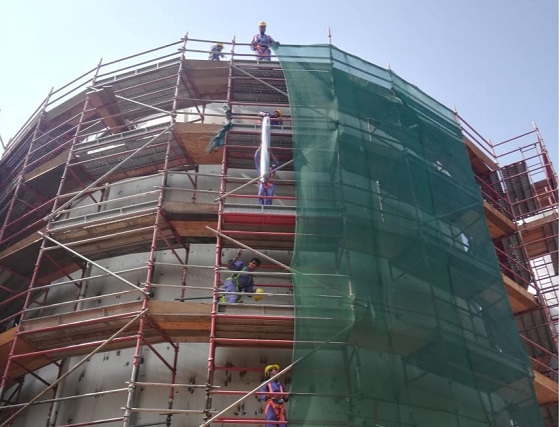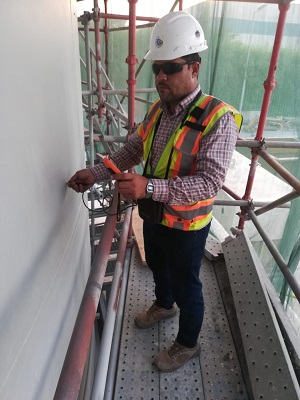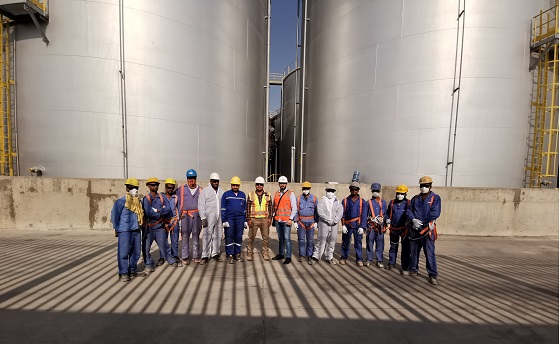Established in 1980, Afia International produces food oils, such as extra virgin olive oil. Although you might not think about the chain of events that must take place to get the olives from the Mediterranean to your stovetop, for example, this is a major step for Afia. Their location in Jeddeh, Saudi Arabia, is a stopping point for the oils. Four holding tanks at that location, adding up to 95,000 square feet (8,825.8 m2) of steel, needed to be properly protected to meet food-based standards.
 The coatings company on the job was Kabbani Construction Group (KCG), one arm of the 60 companies that parent company Islam K. Kabbani (IKK) oversees. At 40+ years old, the construction company is not only considered a leader in the market, according to their website, but KCG is also the first company in the Middle East and only the fourth company worldwide to achieve the 5-Star recognition by NACE International Institute’s Contractor Accreditation Program (NIICAP). That recognition means that the contractor achieved and maintained an average score of 4.0 for both sections of the audit, which “evaluates a company’s business practices, personnel availability, training practices, equipment availability, and company history,” according to the program.
The coatings company on the job was Kabbani Construction Group (KCG), one arm of the 60 companies that parent company Islam K. Kabbani (IKK) oversees. At 40+ years old, the construction company is not only considered a leader in the market, according to their website, but KCG is also the first company in the Middle East and only the fourth company worldwide to achieve the 5-Star recognition by NACE International Institute’s Contractor Accreditation Program (NIICAP). That recognition means that the contractor achieved and maintained an average score of 4.0 for both sections of the audit, which “evaluates a company’s business practices, personnel availability, training practices, equipment availability, and company history,” according to the program.
In addition to those accolades, KCG has also worked with this specific client in the past, including an epoxy floor application, which gave them a leg up on this install. “We, as IKK, have a good [relationship] with the client,” said Basil Al-Mashharawi, estimation engineer at KCG, in an email interview.
It was up to the actual application, then, to bring the project home!
Design, Spec, and Build
Before the coating portion of the project could start, a few important tasks had to be completed. For one thing, the coating system had to be solicited and chosen by the contractors. Then, after picking one, KCG had to get approval from the client for that chosen system.

According to Al-Mashharawi, this included getting the project documents and specs, reaching out to three coating manufacturers that would meet the specs, and assessing how well the systems would meet the criteria. On this project, a Jotun system was chosen and approved for the tanks’ internal and external solutions.
Of course, before coating, the tanks first had to be built! KCG’s sister company, Fulaz Co., fabricated the steel tanks, and they also helped the coatings crew gain access via a manhole and by setting up scaffolding. This included access inside the vessels, where KGC’s coatings work would start. That brings us to the third part of the pre-work: the plan of attack.
As with any of KCG’s projects, this starts with an internal meeting before arriving at the jobsite. When applicable, they decide and notate all jobsite details beforehand. That includes what equipment will be used and how (e.g., spray machines, pressure, and nozzles; wet and dry film thicknesses [WTF and DFT, respectively]; pot life, and percentage of thinning).
Once all of those details are hammered out, the KCG crew was finally able to head to the jobsite!
Divide and Conquer
 The KCG crew members’ work started on the inside of the tanks, where the coatings were certified to protect the steel from “exposure to dry and liquid foods,” per Jotun’s technical data sheet. According to Al-Mashharawi, the crew specifically started on the interior roof, working down the sides to about 1 m (3.3 feet) off the bottom, removing the tarps and other materials from inside, and then coating the floors. Once they finished the inside, they headed outside.
The KCG crew members’ work started on the inside of the tanks, where the coatings were certified to protect the steel from “exposure to dry and liquid foods,” per Jotun’s technical data sheet. According to Al-Mashharawi, the crew specifically started on the interior roof, working down the sides to about 1 m (3.3 feet) off the bottom, removing the tarps and other materials from inside, and then coating the floors. Once they finished the inside, they headed outside.
Throughout the project, the heat and humidity that make up the desert climate of Jeddah were challenges. To mitigate those concerns, since they can affect surface temperatures and application/cure windows, the crew used dehumidification equipment at 10,000 cfm (16,990.1 m3/hour).
Other jobsite equipment included Graco blasting machines with Atlas 850 cfm (1,444.2 m3/hour) air compressors, Airblast ABVR-90 to capture spent abrasives, and a ventilation system to capture the dust. Surface prep of the new steel included blasting to NACE No. 2/Society for Protective Coatings (SSPC) surface preparation (SP) 10, “Near-White Blast Cleaning,” or International Organization for Standardization (ISO) 8501-1’s Sa 2 ½.
During this stage, the crew also used containment and curtain walls and wore personal protective equipment (PPE), such as coveralls, safety shoes, helmets, harnesses, masks, gloves, goggles, and hearing protection. There was an immense amount of safety protocols in place here.
The coating system used included stripe coating on the welded joints, structural edges, and any areas that weren’t accessible with a sprayer. According to Al-Mashharawi, the crew striped immediately after surface preparations were accepted but before each full layer of the coatings, which included:
• 100 microns (3.9 mils) DFT for two layers of the Tankguard Storage coating on all internal surfaces
• 60 microns (2.4 mils) DFT of Penguard as a primer, 130 microns (5.1 mils) DFT of Penguard as a midcoat, and 60 microns DFT of Futura Classic to all external surfaces
It took 10 hours for the internal coatings to cure in an average temperature of 24 °C (75.2 °F), and 3–4 hours for the external surfaces to cure in an average temperature of 35 °C (95.0 °F).
The 13-person crew worked in two teams, two tanks at a time. They were led by Painting Supervisor Isam Husny, and all of the coating crew’s work was double, triple, even quadruple checked by the painter, supervisor, and inspector. That included confirming wet and dry film thicknesses, as well as adhesion tests.

Finishing Touches
After two months, it was time to wrap it up. Before they could head home for their own stovetop suppers on that final day, the KCG crew had one more task to complete: cleanup. Throughout the project, any waste that was inside the tank had to be “shifted outside… to the permitted areas, as per government rules,” Al-Mashharawi said. Empty coating containers were disposed of properly as chemical waste through a third-party specialist, and crew and equipment gradually decreased in size as needs decreased.
In the end, the project was completed on time and within budget. “When you have a good management for any project, you will achieve your estimated budget and time… sometimes you will achieve better results than expected,” Al-Mashharawi said.